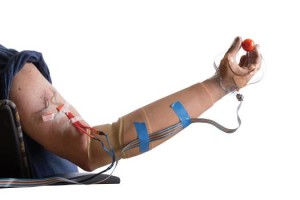
The prosthetic arm plugs into the patient’s electrode implant to create natural-feeling sensations.
Credit: Russell Lee
Prosthetic limbs help amputees with mobility and functionality, but do not allow one to regain their sense of touch. Scientists and engineers have been attempting to re-create touch for those who have lost limbs for some time now, and they may have found the answer.
A study published in Science Translation Medicine states that long-lasting, natural-feeling sensations are now able to be produced artificially for those with prosthetic limbs. Of course, those using the device cannot physically feel the ball. Although, the patterns of electric singles that are sent by a computer into nerves around the patient’s arm will tell him or her differently.
This from Popular Science:
Other groups of researchers have tried to re-create a sense of touch for amputees by buzzing their nerves with electricity… but study volunteers have always reported the resulting sensation was weird, like the pins-and-needles feeling you get when your foot falls asleep. It was as if those old experiments weren’t speaking to the brain in the right language, says Dustin Tyler, a bioengineer at Case Western University and the lead researcher in the study involving Vonderhuevel and Spetic. “We’re beginning to speak the right language now.”
While engineers are still a long way from making a true feeling prosthetic hand, this is a step toward creating prosthetic limbs that convey a natural sense of touch to their users.
This from Engineering.com:
The system, which is limited to the lab at this point, uses electrical stimulation to give the sense of feeling. But there are key differences from other reported efforts. First, the nerves that used to relay the sense of touch to the brain are stimulated by contact points on cuffs that encircle major nerve bundles in the arm, not by electrodes inserted through the protective nerve membranes.
The research team has also developed algorithms that convert the input from sensors taped to a patient’s hand into varying patterns and intensities of electrical signals in order to provide a more natural sensations. Lastly, this system has lasted longer than any other – having patients report sensation lasting two and a half years, as opposed to one month or less in other systems.
Head over to our Digital Library to see how electrochemistry is looking to advance the science of prosthetic limbs.

